استكشاف آليات إضافة القيمة لرموز DeFi
مقدمة
منذ النمو الانفجاري للتمويل اللامركزي (DeFi) خلال "صيف DeFi" لعام 2020، أصبحت العملات الرقمية DeFi عنصرًا حيويًا في السوق الرقمية. كأصول البروتوكولات، آليات إضافة القيمة الخاصة بهم تحدد مباشرة استدامة وجاذبية النظم البيئية الخاصة بهم.
يقوم هذا المقال بفحص آليات إضافة قيمة عملة DeFi من منظورات متعددة، بما في ذلك حقوق الحوكمة، الحوافز لتقاسم الأرباح، التعدين للسيولة، فائدة البروتوكول، التوافق بين السلاسل، واتجاهات الابتكار المستقبلية.
آليات رئيسية
تعتمد عملات DeFi قيمتها على الحوكمة وتقاسم الأرباح وحوافز السيولة وأمان الرهن والفائدة الوظيفية والتكامل عبر النظام الإيكولوجي وقوة العلامة التجارية/المجتمع، التي تمتد عبر الأبعاد التقنية والاقتصادية والثقافية.
تتفاعل آليات متعددة لضمان أن تكون عملات DeFi أصولاً مضاربة وتخلق قيمة دائمة من خلال الفائدة العملية وتوليد العائد وتأثيرات الشبكة. غالبًا ما تجمع المشاريع الرائدة بين آليات متعددة لبناء مزايا تنافسية فريدة.

حقوق الحوكمة
الآلية الأساسية:
تمنح الرموز الحاكمة لحامليها سلطة التصويت على قرارات البروتوكول (على سبيل المثال، هياكل الرسوم، الترقيات)، مما يقوم بتفويت السيطرة من المطورين إلى المستخدمين. على سبيل المثال:
يونيسواب (UNI): تصويتات على إعادة توزيع الرسوم وأزواج تداول جديدة.
Compound (COMP): يعدل نماذج الفائدة وقوائم الأصول.
قيمة الاقتراح:
تعزز الحوكمة شعور المستخدمين بالمشاركة والثقة في المشروع. عندما تتماشى قرارات المجتمع مع مطالب السوق، يتحسن تكيف البروتوكول وتنافسيته، وبالتالي يرتفع قيمة العملة. تشجيع هذا الآلية المستخدمين على المشاركة النشطة وتعزيز تطوير النظام البيئي، وبالتالي تشكيل دورة حميدة.

المصدر:https://atise.medium.com/protocol-fee-sharing-and-the-future-of-uniswap-9c636afeef28
مخاطر:
هجمات الحوكمة والتمركز: إذا كانت لدى حاملي الكميات الكبيرة (الحيتان) كمية كبيرة من الرموز، فيمكنهم التلاعب في نتائج التصويت، مما يؤدي إلى تمركز الحوكمة وتقويض النية الأصلية للتفويض.
اتخاذ قرارات غير فعالة أو غير صحيحة: قد يؤدي نقص المعرفة المهنية أو الآراء المتباينة داخل المجتمع إلى ضبط غير صحيح لمعلمات البروتوكول أو فوات الفرص السوقية. دراسة الحالة - Compound (COMP): في مراحله الأولى، كانت هناك جدل حول تسيطر الحيتان على المقترحات من خلال التصويت، مما أثار مخاوف في المجتمع بشأن العدالة.
التأثير: قد يقلل الحكم غير المتوازن من ثقة المستخدم، ويضعف قيمة العملة المشفرة، وحتى يثير ضغط البيع.
مشاركة الإيرادات
الآلية الأساسية:
يتم التقاط قيمة اقتصادية من خلال مشاركة الإيرادات عن طريق توزيع الدخل الذي تولده البروتوكول (مثل رسوم التداول) على حاملي الرموز، أو من خلال شراء الرموز وحرقها لتقليل العرض المتداول. هذا الآلية مشابهة لتوزيع الأرباح أو recompra de acciones في التمويل التقليدي.
المشاريع والحالات التمثيلية:
سوشي سواب (SUSHI): يمكن لحاملو SUSHI كسب جزء من رسوم التداول على منصة عن طريق رهن رموزهم، مما يحفز على الاحتفاظ بالأموال لفترة طويلة.
MakerDAO (MKR): يقوم البروتوكول بتقليل إمدادات MKR عن طريق شراء الرموز وحرقها. عندما يولد النظام ربحًا زائدًا، يزيد هذا الآلية التضاغية من ندرة الرموز.
قيمة الاقتراح:
تربط مشاركة الإيرادات مباشرة نجاح البروتوكول بقيمة الرمز المميز، مما يوفر لحامليه عوائد شبيهة بالأرباح أو إمكانية الارتفاع المحتمل. تعزز هذه الآلية جاذبية الرمز المميز على المدى الطويل، خاصة بالنسبة للمستخدمين الذين يسعون إلى عوائد مستقرة.

المصدر:https://crypto.com/ar/university/what-is-maker-dao-dai
مخاطر:
الإيرادات غير المستدامة: إذا انخفضت دخل البروتوكول (على سبيل المثال، بسبب انخفاض حجم التداول)، قد لا تكون العوائد الموزعة على المالكين كافية للحفاظ على الاهتمام.
فشل نموذج التضخم: عملية الشراء والحرق تعتمد على ربحية البروتوكول. قد يكون التأثير التضاغي غير ملحوظ إذا كان السوق كسولًا أو تزداد المنافسة.
حالة - سوشي سواب (SUSHI): العوائد العالية المبكرة جذبت المستخدمين، لكن تقلبات حجم التداول أدت إلى مكافآت غير مستقرة، مما أثر على سعر العملة.
تأثير: قد يؤدي انخفاض الإيرادات إلى خسارة لحاملي الرموز وانخفاض قيمة الرمز، خاصة بالنسبة للمستخدمين الذين يعتمدون على العوائد القصيرة الأجل.

المصدر: https://www.gate.io/trade/SUSHI_USDT
حوافز السيولة
الآلية الأساسية:
تجذب حوافز السيولة المستخدمين لتوفير السيولة لحمامات السيولة من خلال توزيع مكافآت العملة، ودعم عمق التداول للبروتوكول ونمو النظام البيئي. الأشكال الشائعة تشمل تعدين السيولة، حيث تقل المكافآت عادة مع مرور الوقت لتحقيق توازن بين التكهنات على المدى القصير والقيمة على المدى الطويل.
المشاريع والحالات التمثيلية:
Curve (CRV): يكافئ رمز CRV مزودي السيولة، ومن خلال آلية veCRV (CRV المقيد للتصويت)، يشجع على قفل الرمز لفترة طويلة لتحسين استقرار رأس المال.
Yearn Finance (YFI): توزع YFI بدايةً عبر التعدين على السيولة، مما جذب كميات كبيرة من رؤوس الأموال لتوسيع بركة السيولة بسرعة.
قيمة الاقتراح:
تحسينات السيولة تعزز كفاءة التداول والتنافسية في السوق للبروتوكول. يمكن لآلية مصممة بشكل جيد (مثل تقليل المكافآت تدريجيًا ودمجها مع استراتيجيات تمكين أخرى) منع خروج رأس المال 'المرتزق' وتعزيز تراكم القيمة على المدى الطويل.

المصدر: https://insights.deribit.com/market-research/yfi-a-tale-of-fair-launch-governance-and-value/
المخاطر:
خروج "رأس المال الساعي للربح":
تعتبر العوائد العالية من تعدين السيولة جذبًا للمضاربين على المدى القصير. بمجرد أن تقل الجوائز، قد ينسحب رأس المال بسرعة، مما يؤدي إلى انكماش حوض السيولة.
الخسارة الزائدة المؤقتة (IL):
مزودي السيولة يواجهون مخاطر تقلب الأسعار. إذا انخفضت قيمة العملة المشفرة، قد تعوض الخسائر المكتسبة.
حالة - عامن Finance (YFI):
بعد الانفجار الأولي للتعدين، رأت بعض حمامات السباحة انخفاضًا حادًا في السيولة بسبب تقليص المكافآت.
تأثير:
قد يؤثر السيولة غير المستقرة على وظائف البروتوكول، وقد يتعرض سعر العملة لضغط البيع.
الرهان والأمان
الآلية الأساسية:
يتطلب الحصول على عوائد من تشغيل العملات الرقمية من المستخدمين قفل العملات لدعم أمن البروتوكول أو استقراره، عادة ما تكون خدمة كصندوق وقائي للحماية ضد المخاطر. يتم مكافأة مشغلي العملات الرقمية بحوافز إضافية. يتم رؤية هذا الآلية عادة في بروتوكولات الإقراض أو العقود المشتقة.
المشاريع والحالات التمثيلية:
Aave (AAVE): يمكن رهن رموز AAVE في "الوحدة الأمنية" واستخدامها كحماية في حال تكبد البروتوكول خسائر (على سبيل المثال، بسبب سيولة دون الكفالة). يتلقى الرهانون مكافآت مقابل ذلك.
المنحنى (CRV): من خلال قفل CRV، يعزز المستخدمون استقرار حمامات السيولة. يتلقى المراهنون قوة تصويت أعلى وعائد أعلى.
قيمة الاقتراح:
يعزز الرهان مرونة الموجه بينما يقلل من الإمداد الدائري للرمز، مما قد يدفع بسعره إلى الارتفاع. من خلال الرهان، يشارك المستخدمون في تطوير النظام البيئي، مما يعزز انخراط المجتمع وتعزيز الدعم على المدى الطويل بشكل أقوى.

المصدر: https://github.com/aave/aave-stake-v2
مخاطر:
ثغرات العقود الذكية: يمكن أن تصبح الأموال المرهونة هدفًا للقراصنة. إذا كانت هناك ثغرات في العقد الذكي، فقد يتم سرقة الرموز المرهونة.
مخاطر تقلب السوق: خلال فترة القفل، إذا انخفض سعر العملة المشفرة، فإن الذين يقومون بالمراهنة قد يتكبدون خسائر كبيرة.
حالة - Aave (AAVE): على الرغم من عدم حدوث هجمات كبيرة، إلا أن حوادث استغلال عقود الذكاء الاصطناعي المتكررة في صناعة DeFi (على سبيل المثال، اختراق كريم فاينانس في عام 2021) تسلط الضوء على المخاطر المحتملة لآليات الرهان.
تأثير: يمكن أن تدمر حوادث الأمان ثقة المستخدم، مما يؤدي إلى انخفاض حاد في قيمة العملة وإشعال أزمة الثقة في النظام البيئي.
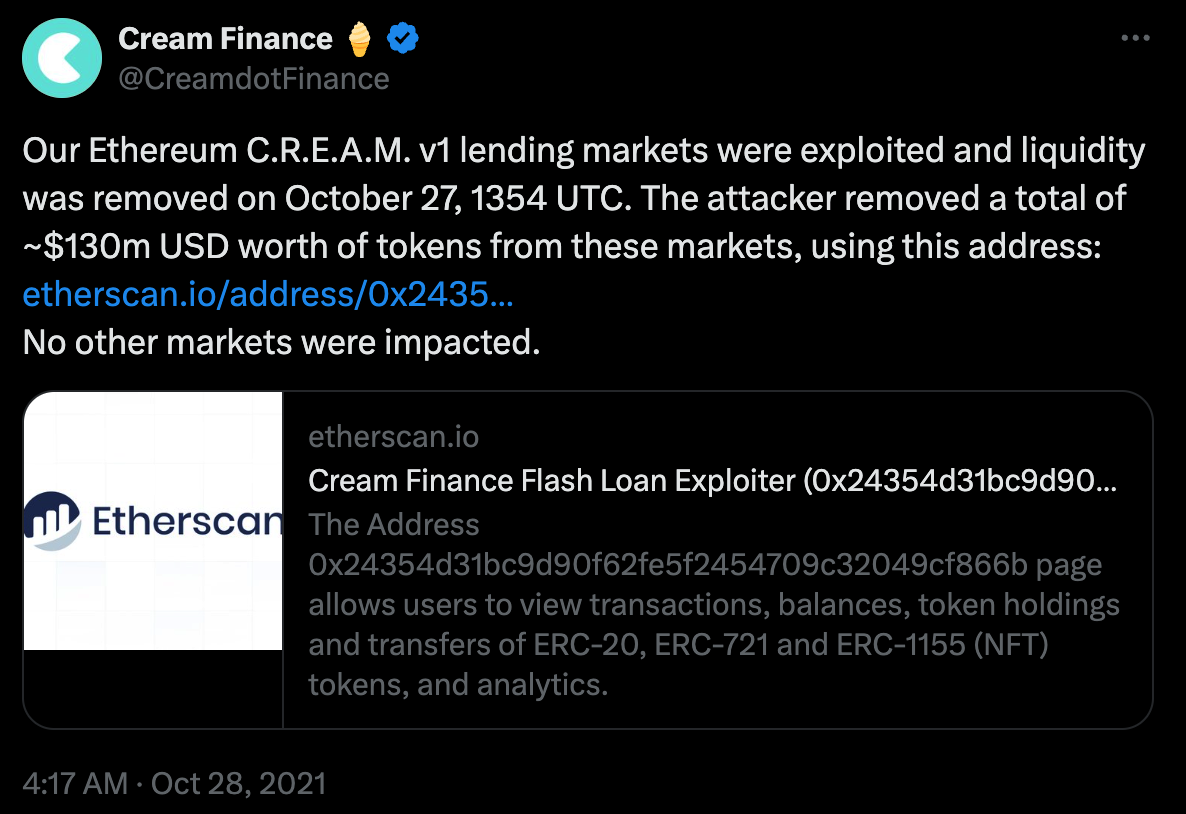
المصدر: https://x.com/CreamdotFinance/status/1453455806075006976
حالات استخدام الأدوات
الآلية الأساسية:
حالات الاستخدام الخدمية تضم الرمز إلى الوظائف الأساسية للبروتوكول - مثل دفع الرسوم، وضبط المعلمات، أو فتح الخدمات - مما يجعل الرمز أساسيًا لاستخدام البروتوكول. تعزز هذه العملية العملية الطلب الجوهري على الرمز.
المشاريع والحالات النموذجية:
بالانسر (BAL): تستخدم عملة BAL لضبط أوزان حمامات السيولة، مما يتيح لأصحابها تحسين عوائد الحمام.
Chainlink (LINK): يُستخدم LINK لدفع رسوم خدمات الأوراقل. مع اعتماد DeFi بشكل متزايد على البيانات الخارجية، يستمر الطلب على LINK في الزيادة.
قيمة الاقتراح:
الأداة تحول العملات المشفرة من الأصول المضاربية إلى ضروريات، مما يعزز الطلب السوقي. بدون العملة، لا يستطيع المستخدمون الوصول بشكل كامل إلى خدمات البروتوكول - هذه اللاستبدالية تزيد مباشرة من قيمة العملة.
مخاطر:
الاستبدال التنافسي: إذا قدمت بروتوكولات أخرى وظائف مماثلة بتكلفة أقل، فإن الطلب على فائدة الرمز الخاص قد ينخفض.
الاعتماد على العوامل الخارجية: يمكن للنظم البيئية الخارجية أن تؤثر على قيمة الرموز المدفوعة. على سبيل المثال، تعتمد Chainlink (LINK) على الطلب داخل سوق الأوراق المالية.
الحالة - بالانسر (BAL): مواجهة المنافسة من منصات مثل يونيسواب، إذا فقدت ميزات بالانسر جاذبيتها، قد يضعف الطلب على BAL.
التأثير: قد يؤدي الانخفاض في الفائدة الوظيفية إلى فقدان العملة دعم قيمتها الأساسية، مما يضعف موقفها في السوق.

المصدر: https://www.gate.io/trade/BAL_USDT
التكامل بين النظامين البيئيين
الآلية الأساسية:
تعزز التكامل بين النظم البيئية تفاعل الرموز وتأثيرات الشبكة من خلال تمكين الاستخدام عبر سلاسل أو بروتوكولات متعددة. هذا النهج شائع في جسور السلاسل المتقاطعة أو بروتوكولات المجمّع، حيث يربط الرمز بين بيئات مختلفة.
المشاريع والحالات التمثيلية:
THORChain (RUNE): تعمل RUNE كعملة تسوية في شبكة سيولة عبر السلاسل، تدعم تبادل الأصول عبر سلاسل متعددة.
Curve (CRV): يتم استخدام CRV من قبل بروتوكولات جامع العوائد مثل Yearn، مما يوسع تطبيقه ضمن نظام البنية التحتية المالية اللامركزية DeFi.
قيمة الاقتراح:
توسيع التكامل بين النظام البيئي يوسع سيناريوهات استخدام العملة والطلب على السيولة، مما يخلق دورة ردود فعل إيجابية من خلال آثار الشبكة. يعزز هذا الأداة المتعددة النفعية قدرة العملة على اصطياد القيمة.
مخاطر:
مخاطر تكنولوجيا السلسلة المتقاطعة: قد تعاني جسور السلسلة المتقاطعة من الأعطال التقنية أو الهجمات الإلكترونية، مما قد يؤدي إلى فقدان الأصول والثقة المخفضة في العملة.
التبعية للنظام البيئي: إذا فشلت البروتوكولات الشريكة، فقد يتعرض قيمة العملة لأضرار جانبية.
الحالة - THORChain (RUNE): في عام 2021، تعرض البروتوكول لعدة حوادث قرصنة، مما أدى إلى تقلبات في السعر لـ RUNE وانخفاض في ثقة المستخدم.
تأثير: يمكن أن تزيد عدم الاستقرار في التكاملات عبر السلاسل من المخاطر، مما يضعف تأثير الشبكة التوكينية ويقلل من قيمتها.
العلامة التجارية والمجتمع
الآلية الأساسية:
العلامة التجارية وبناء المجتمع يبنيان الاعتراف والتوافق الثقافي حول الرمز، مما يمنحه قيمة لا ملموسة. المجتمع القوي لا يروج فقط للمشروع ولكنه أيضًا يوفر الدعم في أوقات الأزمات.
المشاريع والحالات التمثيلية:
ييرن فاينانس (YFI): حصلت على دعم المجتمع من خلال "إطلاق عادل" (لا تعدين مسبق، لا توريد رأس المال الاستثماري). على الرغم من الوظائف المحدودة، دفع التوافق المجتمعي القوي تقدير السعر.
سوشي سواب (SUSHI): في وقت مبكر، تولت المجتمع تطوير المشروع، مما يظهر مرونة المشروع اللامركزي.
قيمة الاقتراح:
على الرغم من صعوبة تقديرها، يمكن أن يوفر التمييز التجاري والمجتمع الدعم الأساسي خلال الاضطرابات السوقية. يمكن للمجتمع القوي أن يتخذ إجراءات جماعية خلال الأزمات (على سبيل المثال، بعد الاختراق)، مما يعزز استقرار المشروع على المدى الطويل.
المخاطر: تجزؤ المجتمع: الصراع الداخلي أو أزمة الثقة (على سبيل المثال، رحيل المطورين الأساسيين) يمكن أن يؤدي إلى انهيار المجتمع وفقدان قيمة العلامة التجارية.
الاعتماد المفرط على التوافق: إذا كانت قيمة الرمز الخاص بالعملة تعتمد بشكل رئيسي على اعتقاد المجتمع بدلاً من الفائدة الفعلية، فإنها تواجه خطر أن تصبح "عملة تضخيمية".
حالة - سوشي سواب (SUSHI): رحيل المؤسس المجهول أثار أزمة ثقة في المجتمع، مما أدى إلى انخفاض سعر العملة.
التأثير: قد يدفع عدم استقرار المجتمع بعيدا الداعمين، ما يؤدي إلى تآكل القيمة غير الملموسة وتفاقم تقلب أسعار العملة.

المصدر: https://news.bitcoin.com/sushiswap-founder-reportedly-exit-scams-as-sushi-token-price-tanks/
مخاطر عامة
مصدر المخاطر:
مع توسع نطاق وتأثير الـ DeFi، بدأت الوكالات التنظيمية العالمية تركز على قضايا الامتثال الخاصة به. من بين التدابير التنظيمية المحتملة:
متطلبات KYC/AML: فرض التحقق من هوية المستخدم، والذي قد يتعارض مع الطبيعة اللامركزية لـ DeFi.
تطبيق قوانين الأوراق المالية: إذا تم تصنيف الرموز كأوراق مالية، فقد تواجه متطلبات التسجيل والإفصاح الصارمة.
سياسات الضرائب: فرض الضرائب على التداول، ومكافآت الحصص، أو حوافز التعدين، مما يزيد من تكاليف المستخدم.
التأثير المحتمل:
قد تضعف القيود التنظيمية من فتح DeFi والوصول العالمي، مما يؤدي إلى تراجع عدد المستخدمين.
قد يضطر المشاريع إلى ضبط الآليات (على سبيل المثال، تقييد بعض الوظائف)، مما يؤثر على النموذج الاقتصادي للعملة وقيمتها.
القلق قد يثير الذعر في السوق، مما يضع ضغطًا سلبيًا على أسعار العملات.
دراسات الحالة:
يونيسواب (UNI): في عام 2021، قامت هيئة الأوراق المالية والبورصات الأمريكية بالتحقيق في يونيسواب لابز، مما أثار مخاوف المجتمع حول تنظيم صرف العملات الرقمية. على الرغم من أن العملة لم تتأثر مباشرة، إلا أن المشهد السوقي تأثر سلبا.
تنظيم العملات المستقرة: واجهت الرموز مثل USDT و USDC انتباهًا تنظيميًا، مما يؤثر بشكل غير مباشر على نظم الديفي التي تعتمد على العملات المستقرة.
تأمل موسع:
إذا ظهر إطار تنظيمي عالمي موحد لـ DeFi في المستقبل، فقد تغادر المشاريع الصغيرة إلى المتوسطة الحجم السوق بسبب تكاليف الامتثال العالية، بينما قد تهيمن البروتوكولات الكبيرة. وقد يؤثر هذا على تنوع نظام العملات.

المصدر: https://www.ccn.com/analysis/crypto/uniswap-uni-price-support-sec-investigation/
التقلب في مشاعر السوق
مصدر الخطر:
يعتبر سوق العملات الرقمية موضوعا للتكهنات بشكل كبير، وأسعار العملات الرقمية DeFi غالبا ما تكون مدفوعة من قبل العوامل التالية:
التغييرات الاقتصادية الكبرى: على سبيل المثال، الإجراءات مثل رفع الاحتياطي الفيدرالي للفائدة أو الركود الاقتصادي تؤدي إلى انتقال رؤوس الأموال بعيدًا عن الأصول عالية المخاطر.
الترويج للسوق و FUD (الخوف والشك والشك): الشائعات أو البيانات العاطفية على منصات التواصل الاجتماعي (مثل تويتر / إكس) يمكن أن تثير عمليات الشراء والبيع غير المنطقية.
تأثير سيطرة بيتكوين: تؤثر تقلبات سعر بيتكوين في كثير من الأحيان على السوق بأكمله، ونادراً ما تكون عملات ديفي غير معرضة لهذا التأثير.
التأثير المحتمل:
قد تنفصل أسعار العملات المشفرة عن الأسس الأساسية للمشروع، مع ذروات وانهيارات قصيرة الأجل تقوض ثقة المستثمرين طويلة الأمد.
قد تؤدي التقلبات العالية إلى انسحاب مزودي السيولة من استثماراتهم، مما يزيد من عدم استقرار النظام البيئي.
يمكن أن يحجب الأجواء المضاربية القيمة الحقيقية لمشروع ما، مما يزيد من خطر انفجار الفقاعة.
دراسات الحالة:
سوق الدب 2022: انهيار تيرا (LUNA) أثار رد فعل متسلسل، مما تسبب في انخفاض حاد لعدة رموز DeFi (مثل AAVE و CRV) بجانب المشاعر السوقية، على الرغم من عدم تضرر بروتوكولاتها مباشرة.
التنبيه المبكر لـ YFI: ارتفعت عملة YFI التابعة لشركة Yearn Finance في عام 2020 بسبب حماس المجتمع، لكن التصحيح اللاحق أبرز استقرار المشاعر السوقية.
تأمل موسع:
مخاطر الإحساس بالسوق من الصعب تجنبها تمامًا، ولكن يمكن للمشاريع الحصول على مرونة نسبية خلال التقلبات من خلال التواصل الشفاف والأسس القوية (مثل القيمة الإجمالية للرهونات أو الإيرادات الفعلية).
الاعتماد التكنولوجي
مصدر الخطر:
تعتمد قيمة ووظائف رموز DeFi على التكنولوجيا الأساسية للبلوكشين، التي قد تواجه المشاكل التالية:
ازدحام الشبكة والرسوم المرتفعة: على سبيل المثال، يمكن أن يقلل ارتفاع رسوم الغاز في إثريوم من قابلية استخدام البروتوكول.
مشاكل التوافق بين السلاسل: قد تواجه النشر المتعدد السلاسل تأخيرات أو أخطاء بسبب التقنية الناضجة.
فشل البنية التحتية: قضايا مثل انقطاع العقدة أو ثغرات آلية التوافق يمكن أن تؤثر على تنفيذ المعاملة.
التأثير المحتمل:
قد تدفع التكاليف العالية أو الكفاءة المنخفضة المستخدمين إلى التحول إلى سلاسل تنافسية (مثل سولانا أو بي إس سي)، مما يضعف نظام العملة.
الأعطال التقنية قد تؤدي إلى فقدان الأموال، وتؤدي إلى تآكل ثقة المستخدم، وتثير بيع العملات المشفرة.
الاعتماد المفرط على سلسلة كتل واحدة (على سبيل المثال، إثريوم) قد يقيد قدرة المشروع على التوسع.
دراسات الحالة:
أزمة رسوم الغاز في إيثيريوم لعام 2021: شهدت يونيسواب وأف، بالإضافة إلى بروتوكولات أخرى، زيادة كبيرة في تكاليف المعاملات، مما أدى إلى تحويل المستخدمين إلى حلول الطبقة 2 أو سلاسل أخرى، مما أثر على استخدام العملات المميزة في الأجل القصير.
تعطل شبكة سولانا: شهدت سولانا عدة انقطاعات في عام 2021، مما أثر على مشاريع ديفي مثل سابر وقلص من أسعار العملات.
تفكير موسع:
مع تطور حلول الطبقة 2 (مثل Arbitrum و Optimism) والنظم البيئية المتعددة السلاسل، قد يتم تخفيف مخاطر الاعتماد التكنولوجي. ومع ذلك، يمكن أن يؤدي اعتماد التقنيات الجديدة أيضًا إلى إدخال عدم يقين جديد، مثل قضايا أمان الجسر عبر السلاسل.

المصدر: https://www.helius.dev/blog/solana-outages-complete-history
عدم قابلية استدامة النموذج الاقتصادي
مصدر الخطر:
تعتمد العديد من الرموز DeFi على نماذج عائد عالي أو تضخمية لجذب المستخدمين، لكن استدامتها على المدى الطويل محل شك:
تضخم زائد: يمكن أن تخفف إصدارات الرمز المرتفعة في وقت مبكر (على سبيل المثال، مكافآت التعدين) من قيمتها.
الاعتماد على الأموال الخارجية: إذا تباطأ تدفق المستخدمين الجدد، فإن النماذج شبه بونزي قد تنهار.
المنافسة المتزايدة: المشاريع الجديدة تحول الأموال والاهتمام، مما يضعف جاذبية الرموز الحالية.
التأثير المحتمل:
التضخم الزائد قد يؤدي إلى انخفاض طويل الأمد في أسعار العملات، مما يقوض ثقة المالكين.
المشاريع التي تفتقر إلى مصادر دخل جوهرية قد تفشل في الحفاظ على النظام البيئي، مما يؤدي إلى تحول العملة إلى عملة "ضخ وتفريغ".
قد تضغط التشبع السوقي على حدود الربح، مما يقلل من الإمكانيات التقديرية لجميع الرموز.
دراسات الحالة:
تيرا (LUNA): انهار النموذج عالي العائد الذي يعتمد على استقرار UST في عام 2022، مكشوفة المخاطر القاتلة للتصميم الاقتصادي غير المستدام.
مشاريع تعدين السيولة المبكرة: على سبيل المثال، انخفضت يام فاينانس بسرعة بسبب التضخم غير المضبوط والعوائد العالية غير المستدامة.
تأمل موسع:
المشاريع الناجحة تحتاج إلى التحول إلى نماذج مستدامة ذاتية التمويل (على سبيل المثال، تعتمد على الرسوم)، ولكن هذا يتطلب قاعدة مستخدمين كبيرة واعترافاً من السوق، وهو أمر صعب يصعب تحقيقه بالنسبة للمشاريع الصغيرة والمتوسطة الحجم.
مخاطر العدوى النظامية
مصدر الخطر:
يعتبر نظام DeFi مرتبطًا بشكل كبير، وفشل مشروع واحد قد يؤدي إلى تفاعل سلسلة:
الترابط بين البروتوكولات: على سبيل المثال، البروتوكولات الاقتراضية التي تعتمد على المهتزات أو العملات المستقرة - قضايا في وصلة واحدة يمكن أن تؤثر على النظام بأكمله.
الرافعة المالية الزائدة: يمكن أن تؤدي تصفية المستخدمين ذوي الرافعة المالية العالية إلى إحداث أزمة، مما يؤثر على استقرار بركة السيولة.
الأحداث البجعة السوداء: الاختراقات الرئيسية أو انهيارات السوق يمكن أن تؤثر على الصناعة بأكملها.
التأثير المحتمل:
خطر انتشار رمز واحد في جميع أنحاء النظام يمكن أن يؤدي إلى انخفاض سعر عدة رموز.
أزمة الثقة قد تؤدي إلى سحب جماعي، مما يقلص القيمة الإجمالية المقفلة بشكل حاد.
تم تمديد دورة الاسترداد، معوقًا تطور الصناعة.
دراسات الحالة:
انهيار تيرا 2022: تسبب فصل UST في انهيار LUNA إلى الصفر، مما أثر على بروتوكولات مثل Anchor وMirror. بسبب الذعر في السوق، شهدت عدة عملات رقمية (على سبيل المثال، CRV، AAVE) انخفاضات.
هاك بولي نتورك 2021: تم اختراق بروتوكول السلسلة المتقاطعة مقابل 613 مليون دولار في عام 2021، مما أثار مخاوف واسعة حول أمان DeFi متعدد السلاسل.
تأمل موسع:
يمكن تخفيف مخاطر النظام من خلال اللامركزية (على سبيل المثال، النشر متعدد السلاسل) وفك الرهن، ولكن القضاء الكامل يصعب ويتطلب نضوج الصناعة بشكل عام.
الرؤية المستقبلية
التقدم التكنولوجي والتكامل اللامركزي متعدد السلاسل
سيصبح تمكين عملات DeFi أكثر تنوعًا وكفاءة بفضل التقدم التكنولوجي، وخاصة مع نضوج التقنيات من الطبقة 2 والتقنيات العابرة للسلاسل. مع استمرار تحسن حلول مثل Arbitrum و Optimism (الطبقة 2) وبروتوكولات عابرة للسلاسل مثل Polkadot و Cosmos، ستصبح العملات مركز القيم في النظم البيئية متعددة السلاسل، مما يوفر تكاليف معاملات أقل وكفاءة أكبر.
بالإضافة إلى ذلك، سيجلب إدخال تقنية البرهان بدون معرفة (ZKP) ميزات الخصوصية، مما يقدم حالات استخدام جديدة للعملات المشفرة في المعاملات الخاصة والأمن. ستعزز تطبيق الذكاء الاصطناعي والتشغيل التلقائي (على سبيل المثال، تحسين الاستراتيجية في Yearn Finance) أيضًا فائدة العملات المشفرة في التمويل الذكي.
تنشأ الفرص من الابتكارات التكنولوجية التي تقلل رسوم الغاز وازدحام الشبكة، وتوسع قاعدة المستخدمين، وتزيد من طلب العملات. قد تؤدي إدخال ميزات الخصوصية أو التكاملات الذكية أيضًا إلى خلق تنافسية سوقية أقوى.
ومع ذلك، فإن إدخال التقنيات الجديدة يجلب أيضًا ثغرات أمنية محتملة وعوائق تقنية. هجمات الجسر العابر للسلاسل وعيوب تنفيذ ZKP يمكن أن تصبح نقاط المخاطر. الرموز العابرة للسلاسل (على سبيل المثال، RUNE) والرموز الخاصة (على سبيل المثال، TORN) يمكن أن تصبح اتجاهات ممثلة في المستقبل.

Source: https://www.chainalysis.com/blog/cross-chain-bridge-hacks-2022/
نضوج السوق وعائد القيمة
مع تحول سوق DeFi تدريجيا من المضاربة إلى القائمة على القيمة ، فإن تمكين الرمز المميز سيركز بشكل أكبر على الاستدامة والمنفعة العملية. قد تكون الرموز المميزة لتقاسم العوائد (على سبيل المثال ، SUSHI و MKR) ، والتي تعتمد على رسوم المعاملات أو الإيرادات الحقيقية ، أكثر جاذبية من النماذج القائمة على التضخم ، على غرار "أصول توزيعات الأرباح" للتمويل التقليدي.
في الوقت نفسه، سيصبح تعزيز العلامة التجارية والاتفاق المجتمعي أحد أهم أركان قيمة العملة، مع "الرموز الثقافية" مثل YFI التي تظهر مرونة أكبر خلال تقلبات السوق.
سيساعد نضوج السوق في تصفية المشاريع القوية من الناحية الأساسية، مما يوفر إمكانية الappraisal على المدى الطويل لعملات الجودة. يمكن أن تدفع تدفقات رأس المال المؤسسية النمو المستمر لـ TVL (القيمة الإجمالية المقفلة)، مما يحسن سيولة الرمز المميز واستقراره.
ومع ذلك، قد يؤدي تقليل الاستثمارات إلى زيادة في التقلبات السوقية على المدى القصير، وقد يضعف مشاركة المؤسسات الروح اللامركزية، مما يتسبب في ردود فعل من المجتمع. قد تصبح توكينة الأصول الحقيقية (مثل استكشاف MakerDAO لـ RWA) ونماذج الدخل الثابتة (على سبيل المثال، veCRV من Curve) معايير في المستقبل.

المصدر:https://beincrypto.com/maker-dao-position-real-world-tokenization-rwa/
تكييف التنظيم وتطور الامتثال
التنظيم سيصبح متغيرًا مهمًا في تطوير عملات DeFi. في المستقبل، قد يظهر نظام مزدوج المسار، يجمع بين الامتثال الاستباقي ونهج الرمل التنظيمي. قد تقوم بعض المشاريع (مثل Aave Pro) بإدخال آليات الامتثال لمكافحة غسيل الأموال ومعرفة العميل لتلبية مجموعات المستخدمين المختلفة. على النقيض، قد تقوم الدول بإنشاء مناطق تجريبية لـ DeFi لتوفير بيئات مراقبة للابتكار في مجال العملات. سيدفع الاستخدام الواسع للعملات المستقرة المنظمة (مثل USDC) عملية الامتثال لـ DeFi بشكل أكبر.
يمكن أن يجذب إطار تنظيمي واضح المزيد من رؤوس الأموال التقليدية والمستخدمين، مما يزيد من شرعية العملة واعتراف السوق. قد تستفيد المشاريع المتوافقة أيضًا من مزايا السياسات.
ومع ذلك، يمكن أن تكبح التنظيمات المفرطة الابتكار، محددة قيمة العملة. يمكن أن تفتت الفروق التنظيمية العالمية السوق وتزيد من تحديات الامتثال للمشاريع عبر الحدود. قد تصبح العملات التي تحكمها الامتثال (على سبيل المثال، COMP) والبيئات الصديقة للتنظيم (على سبيل المثال، Algorand) ممثلين نموذجيين في المستقبل.

المصدر: https://www.circle.com/usdc
تقسيم الوحدات وزيادة القابلية للتركيب
تصميم DeFi المعتمد على الوحدات والقابلية للتركيب يسمح لبروتوكولات مختلفة بالتعاون، مما يخلق نظاماً مالياً "شبيه بليغو" بسلاسة. يمكن لمشاريع مختلفة دمج بعضها البعض وتوسيع بعضها الآخر من خلال عقود ذكية موحدة وواجهات بروتوكول مفتوحة، مما يعزز من مرونة النظام وسرعة الابتكار.
على سبيل المثال، تجمع Yearn Finance بروتوكولات الإقراض المتعددة على Gate.io (على سبيل المثال، Aave، Compound) لتحسين عوائد المستخدم، مما يظهر الاستخدام الفعال للقابلية للتركيب. يوفر نموذج السيولة المركزية في Uniswap V3 أدوات إدارة السيولة لبروتوكولات أخرى (على سبيل المثال، Instadapp، Gelato Network). تسمح تصميم حوض Balancer المعياري للأوزان المخصصة ورسوم التداول، مما يوفر المزيد من الإمكانيات لابتكار بروتوكولات DeFi واستراتيجيات الاستثمار.
تقليل تكاليف التطوير والحواجز من خلال التصميم القابل للتخصيص والذي يسمح للمستخدمين بدمج وتخصيص الميزات بحرية استنادًا إلى احتياجاتهم. ومع ذلك، يمكن أن يؤدي التركيب المعقد للغاية إلى إدخال مخاطر أمان وثغرات في النظام. على سبيل المثال، كشف هجوم Nomad Bridge 2022 عن ثغرات أمان في التفاعلات عبر البروتوكولات. يمكن أن يؤدي عيب أو فشل في مكون واحد إلى تفجير رد فعل سلسلة في جميع أنحاء النظام البيئي. لذا، فإن ضمان التوافق والأمان بين البروتوكولات أمر أساسي أثناء تعزيز التجزئة والقابلية للتركيب.

المصدر: https://yearn.fi/apps/integrations
تكامل الذكاء الاصطناعي والتمويل اللامركزي
تجلب الذكاء الاصطناعي التكنولوجيا مستوى جديدا من الكفاءة وتجربة المستخدم إلى DeFi ، حيث تلعب دورا رئيسيا في التحكم في المخاطر واستراتيجيات الاستثمار وتحسين العقود الذكية من خلال التعلم الآلي وتحليل البيانات الضخمة. من خلال تحليل بيانات السوق في الوقت الفعلي والأنشطة على السلسلة وسلوك المستخدم ، توفر نماذج الذكاء الاصطناعي تنبؤات دقيقة لتسجيل الائتمان والتصفية لبروتوكولات الإقراض (مثل Aave) ، مما يحسن استخدام رأس المال والأمن. تقوم روبوتات التداول الكمي التي تعتمد على الذكاء الاصطناعي (مثل dHEDGE) تلقائيا بتنفيذ استراتيجيات المراجحة وصنع السوق وإدارة الأصول ، وتحقيق عوائد أعلى ومخاطر أقل. بالإضافة إلى ذلك ، يمكن استخدام الذكاء الاصطناعي للتدقيق الآلي واكتشاف الثغرات الأمنية في العقود الذكية ، مما يعزز الأمن والاستقرار بشكل أكبر.
على سبيل المثال، يستخدم Numerai نماذج تعلم الآلة اللامركزية لتوقع الأسواق المالية ويحفز علماء البيانات العالميين على المساهمة بنماذج توقعية من خلال العملات المميزة. تطبق Gauntlet Network الذكاء الاصطناعي لمحاكاة وتحسين تكوينات المعلمات لبروتوكولات DeFi، مما يساعد الأنظمة على الحفاظ على الاستقرار وكفاءة رأس المال تحت ظروف السوق المختلفة.
ومع ذلك ، فإن تكامل الذكاء الاصطناعي و DeFi يواجه أيضا تحديات. إن دقة وعدالة بيانات التدريب ، فضلا عن شفافية الخوارزميات وقابليتها للتفسير ، هي قضايا حالية تحتاج إلى معالجة. بالإضافة إلى ذلك ، يمكن أن تؤدي الأنظمة المؤتمتة للغاية إلى عمليات "الصندوق الأسود" ومخاطر لا يمكن السيطرة عليها. ومن الآن فصاعدا، سيستمر تكامل الذكاء الاصطناعي مع التمويل اللامركزي في دفع عجلة تطوير الأنظمة المالية الذكية، مما يوفر للمستخدمين خدمات أكثر تخصيصا وكفاءة.
تكامل النظام البيئي والتنمية المتنوعة
سيتطور توكنات DeFi من الأصول ذات الوظيفة الواحدة إلى تلك المتكاملة في السيناريوهات المتعددة، مدمجة بعمق مع قطاعات سلسلة الكتل الأخرى مثل NFT و GameFi و SocialFi. يمكن استخدام التوكنات في الإقراض NFT والرهان أو تقاسم الأرباح لتعزيز السيولة (على سبيل المثال، BLUR من Blur). ضمن GameFi، يمكن تحسين الأصول داخل اللعبة لتحقيق الأرباح أو استخدامها في ألعاب مختلفة عبر توكنات DeFi. بالإضافة إلى ذلك، تقدم تكامل أنظمة الهوية اللامركزية (DID) إمكانيات جديدة لقوة التوكن.
يعمل تكامل النظام البيئي على توسيع سيناريوهات استخدام الرموز المميزة ، مما يعزز تأثيرات الشبكة وقدرات التقاط القيمة. يجذب التطوير المتنوع قاعدة مستخدمين أوسع ، مما يدفع DeFi من سوق متخصصة إلى الاتجاه السائد. ومع ذلك، قد يؤدي التكامل عبر المجالات إلى زيادة تعقيد النظام، مما يزيد من حواجز التطوير ودخول المستعملين. في الوقت نفسه ، قد تؤدي المنافسة عبر مختلف المجالات إلى تحويل الموارد ، مما يضعف القدرة التنافسية الأساسية لرموز DeFi. قد تلعب رموز NFT-Fi (على سبيل المثال ، BEND من BendDAO) ورموز SocialFi (على سبيل المثال ، Friends.tech) دورا مهما في هذا الاتجاه.

المصدر: https://www.benddao.xyz/en/
استنتاج
نظرًا للأمام، ستستمر تطور DeFi في اتجاه التنويع والذكاء. مع تحسين الهياكل النمطية وزيادة قابلية التكامل، ستزيد توافقية وكفاءة بروتوكولات DeFi بشكل أكبر، مما يوفر للمستخدمين خدمات مالية شاملة أكثر وسيناريوهات مبتكرة. ستدفع التكنولوجيا الذكية العميقة للأمام أيضًا نحو تحقيق اختراقات في مجال مراقبة المخاطر وتحسين الاستراتيجيات والأمان، مما يوفر للصناعة حلولًا أكثر ذكاءً وكفاءة.
ومع ذلك، يأتي تطوير مستقبل DeFi أيضًا مع مخاطر وتحديات. قد تجلب التكامل البيئي والتعاون عبر النطاقات تعقيد النظام ومخاطر أمنية محتملة؛ وقد تؤدي طبيعة التكنولوجيا الذكية والانحيازات في البيانات إلى قضايا شفافية وتقييم خاطئ؛ وقد تؤثر سياسات التنظيم غير المؤكدة على استدامة وامتثال الصناعة بأكملها.
نتطلع إلى الأمام، فإن طريق الابتكار في مجال DeFi مليء بالفرص والتحديات. إن DeFi لن يتمكن حقاً من الانتقال إلى السوق الرئيسية وتحقيق تطبيقات أوسع والاستفادة من القيمة إلا من خلال تحقيق توازن بين الأمور التالية: الأمان التكنولوجي، تحسين تجربة المستخدم، وإدارة المخاطر.
المقالات ذات الصلة
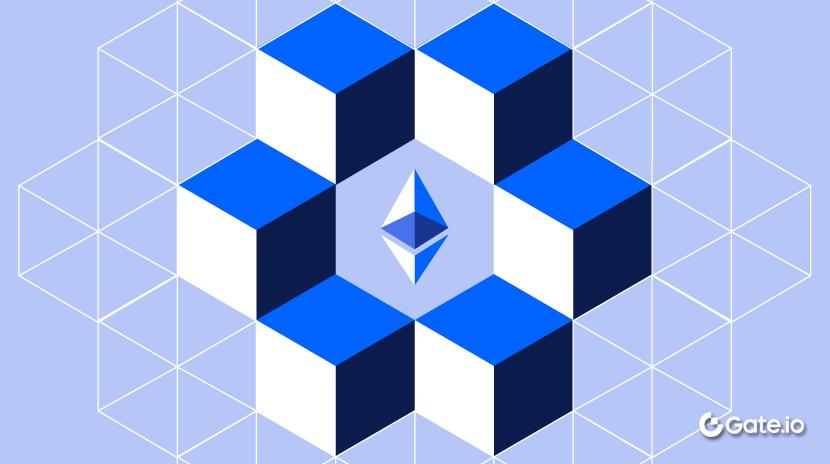
كيفية تخزين ETH?
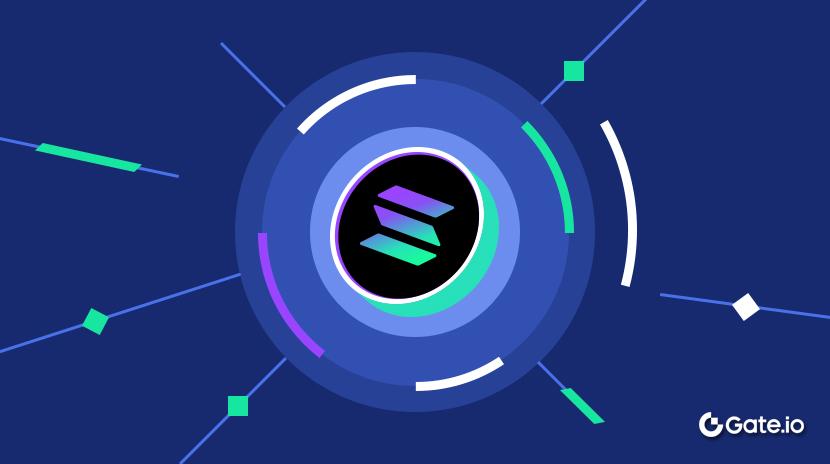
ما هو سولانا?

كل ما تريد معرفته عن Blockchain
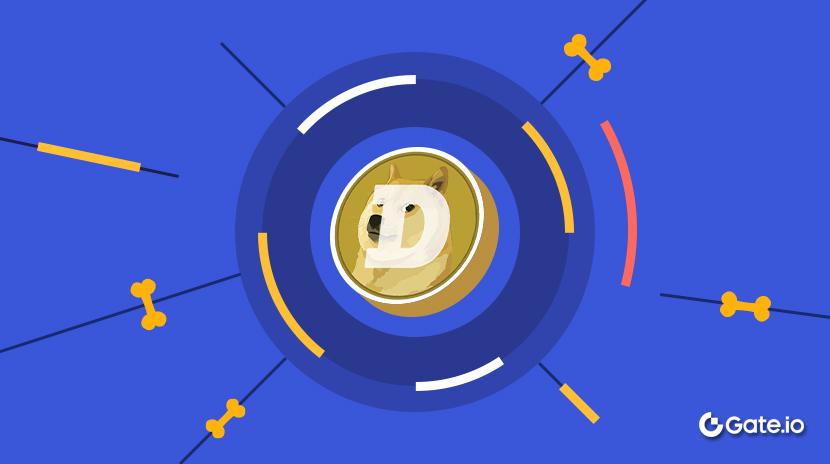
ما هو دوجكوين؟
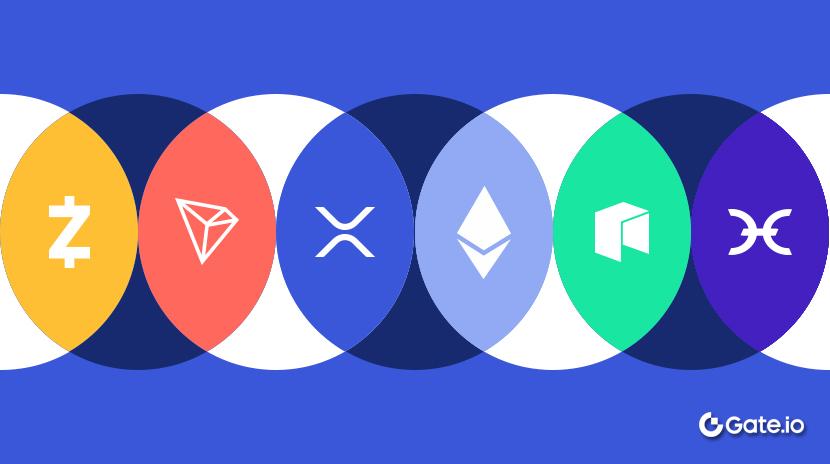
ما هي العملات البديلة؟






